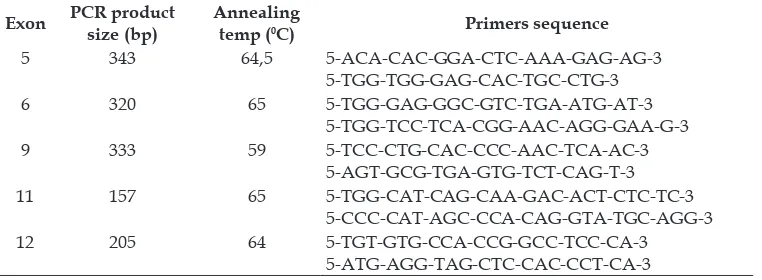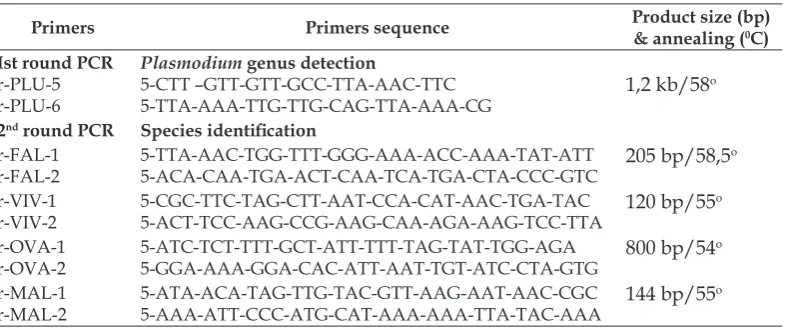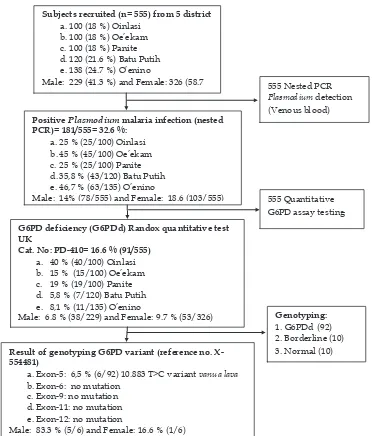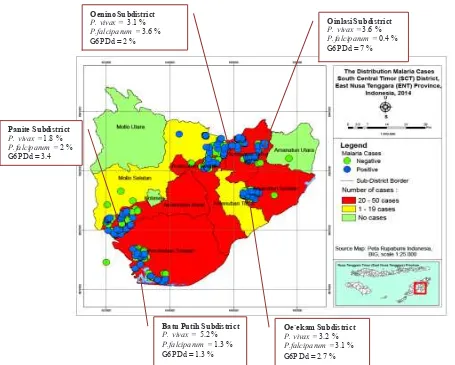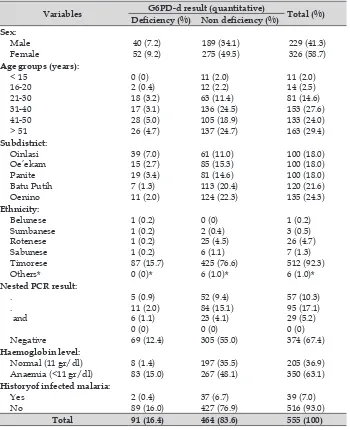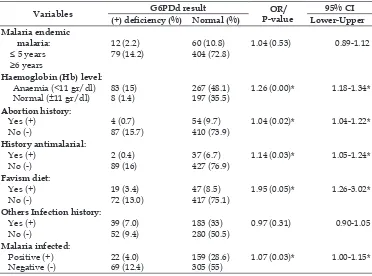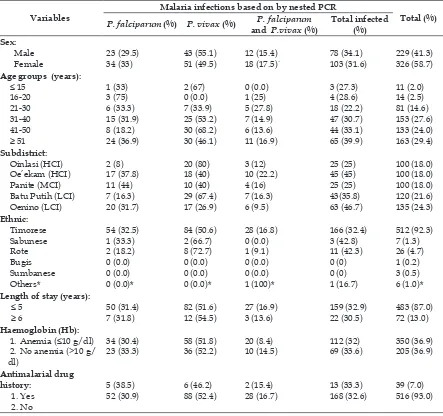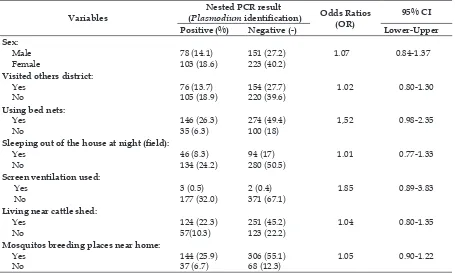I.J. Biotech, Vol. 20, No. 2 Hutagalung et al.
The irst evaluation of glucose-6-phospate dehydrogenase deiciency (G6PD)
gene mutation in malaria endemic region at South Central Timor (SCT)
district, Eastern Indonesia 2014–2015
Jontari Hutagalung
1*, Hari Kusnanto
1, Supargiyono
2, Purwono
2, Sadewa Ahmad
Hamim
3, Darojatun Ida
3, Satyagraha Ari Winasti
4, Novijanti Rintis
4, Triwibowo
A. Garjito
5, Mega Tyas Prihatin
5, Bai Apris
6, Bansai Immanuel
6, Kik Hao Samuel
6Hananta Linawati
71 Research unit Tropical Medicine (Tropmed), Faculty of Medicine, Universitas Gadjah Mada, Yogyakarta, Indonesia
2 Department of Parasitology, Entomology and Tropical Disease, Faculty of Medicine, Universitas Gadjah Mada, Yogyakarta, Indonesia
3 Department of Biochemistry, Faculty of Medicine, Universitas Gadjah Mada, Yogyakarta, Indonesia.
4 Laboratory red blood cell and enzyme disorder, Eijkman Institute for Molecular Biology, Jakarta, Indonesia.
5 Institute for Vector & Reservoir Control Research & Development (IVRCR&D), National Institute of Health Research and Development, Ministry of Health, Salatiga, Cental Java, Indonesia.
6Health ofice of Timor Tengah Selatan District and Malaria Laboratory, Soe, Nusa Tenggara Timur Province, Indonesia.
7 Department of Pharmacology and Pharmacy, Faculty of Medicine, University of Catholic Atmajaya, Jakarta, Indonesia
Abstract
Primaquine (PQ) is a key drug in the malaria pre-elimination stage. However, PQ can trigger acute hemolysis for people with G6PD deiciency (G6PDd). In 2013, 15–25 million Indonesian people were infected with malaria, with 30,000–38,000 deaths each year mostly in eastern Indonesia with API= 15.6 %. Recently, the Ministry of Health of the Republic of Indonesia announced a plan to reach the pre-elimination stage based on WHO guidelines. This study assesses whether eastern Indonesia should proceed with the activities of malaria pre-elimination. A total 555 healthy people in ive subdistricts in eastern Indonesia were selected by systematic random samping. All data were collected using a standard questionnaire, physical examination, and laboratory tests. PCR and DNA sequencing protocols followed respective manufacture’s instructions. Statistical analysis by bivariate with α= 0.05 and 95% CI were performed using the SPSS software package. Based on the nested PCR, the result showed a malaria prevalence of 32.6% with being the dominant species (52.5%). Malaria cases were found in all study sites and not using a bed net was the moost signiicant risk factors with Exp B= 1.54 with 95% CI= 0.99–2.38. G6PDd prevalence was 16.6%, the highest G6PDd ever found in Indonesia with variant molecular dominant 10.883 T>C and one sample with a heterozygous female. Malaria pre-elimination in eastern Indonesia should be delayed. High risk patients should be tested for enzyme G6PD activities before antimalarial administration.
Keywords: G6PDd,Vanua Lava, Pre-elimination malaria, Eastern Indonesia
*Corresponding author: Jontari Hutagalung
Research unit Tropical Medicine (Tropmed), Faculty of Medicine, Universitas Gadjah Mada, Yogyakarta, Indonesia.
Vol. 20, No. 2, pp.117-132
Introduction
Glucose-6-phosphate dehydrogenase
(G6PD) is an X-linked essential enzyme
that protects cells from oxidative stress, particularly in red blood cells (RBC). G6PD deficiency (G6PDd), the most common
known enzymopathy, is a hereditary genetic
defect and it is one of the most prevalent polymorphisms in humans, especially in males (Kyoung et al., 2014). G6PD is an enzyme
that plays an important role in protecting cells from oxidative damage by producing nicotinamide adenine dinucleotide phosphate (NADPH) and reducing glutathione (GSH) in the erythrocyte. The G6PD gene is highly polymorphic with almost 400 reported variants, and is more commonly found in males than in females. This has led to the speculation that malaria has been the selection pressure that has favored the maintenance of this potentially deleterious
trait. There is some evidence that hemizygous and heterozygous G6PDd may be protected
against severe malaria. Most of individuals with G6PDd are normally asymptomatic, however, erythrocyte exposure to oxidative stress causes haemoglobin (Hb) denaturation, and ultimately results in haemolysis. Haemolytic anemia in G6PDd can be triggered by a range of oxidative agents, such as infections and certain foods and drugs,
including antimalarial 8-aminoquinolines like primaquine (Luzattoet al., 2001; Beutler and Vullamy, 2002; Clark et al., 2009).
Primaquine is the 8-aminoquinolines,
a class of drugs discovered almost 80 years
ago. Primaquine is administered to patients infected with (hypnozoites)to prevent relapse
as wll as with to reduce gametocyte carriage to block transmission (Beutler et al., 1995).
People with G6PD deiciency more susceptible to hemolysis when taking primaquine.
Recently, the Ministry of Health (MoH) of the Republic of Indonesia announced a plan to reach the pre-elimination stage by 2015–2020 and to be free of malaria transmission by
2030, and that it will use the World Health Organization (WHO) guidelines for
elimination activities. WHO criteria for
pre-elimination are a reduction to zero incidence
where the annual parasite incidence (API)=
<1/1,000 population, no local transmission,
and with no risk factors for three consecutive
years (Elyazar et al., 2011; Kemenkes RI, 2013;
WHO, 2014).
In 2011–2014, there were 4.8 million cases of malaria reported in eastern Indonesia
with (62%) and (33%)being the most common species (Elyazar et al., 2011; WHO, 2014). In this region, malaria is the primary cause of
mortality with 23,483 deaths. South Central
Timor (SCT) District, one of the highest malaria prevalence rates in eastern Indonesia with API= 15.6% for more than 10 years following mother mortality rate (MMR) and infant mortality rate (IMR), twice higher than
the national average (Kemenkes RI, 2013; Dinkes Prov. NTT, 2013; Dinkes TTS, 2014).
About 49 of 61 countries had failed to achieve malaria elimination in 2010. A review of resurgence in the Philippines and Thailand and two provinces in Indonesia, (Central Java and Kepulauan Seribu Island) that successfully pre-eliminated because of continued active control programs and
passive case inding, and strong initiatives
with neighboring countries, such as vector control, available operational drugs, and good surveillance systems (WHO, 2007; Feachem et al., 2010; Maharaj et al., 2012).
Malaria pre-elimination will be possible only with serious attempts to address asymptomatic and chronic infections by both and Currently in Indonesia, the available drugs that can completely clear a human of for radical cure and that can reduce the transmission of malaria parasites are those in
primaquine, however, people with G6PDd
I.J. Biotech, Vol. 20, No. 2 Hutagalung et al.
G6PDd prevalence and the variant molecular in a malaria endemic region regarding whether eastern Indonesia should proceed malaria pre-elimination activities.
Materials and methods Ethics statements
This study was approved by the ethics committee of the Faculty of Medicine, Universitas Gadjah Mada, Yogyakarta
(reference No: KE/FK/85/EC). All
participants signed a written consent form and gave their permission for the collection of blood samples.
Samples
A survey was conducted from August
2013 to September 2014. Sample size was
calculated using a malaria prevalence
of 15.6% in 2013 in South Central Timor
District, eastern Indonesia (Lemenshow et al., 1997). Criteria for inclusion were ≥14 years of age and hemoglobin (Hb) level= ≥ 11 gr/dL by using HemoCue (HemoCue, 2013). Participants were interviewed face to face with a standard questionnaire, while
household locations were obtained using the Garmin GPS 76, USA (Garmin International Inc., 2006). All participants underwent a physical examination by local health practitioners. During the interview, thick and thin blood smears (Giemsa 5%) were made
for malaria identiication(Eijkman Institute for Molecular and Kemenkes RI, 2010).
Determination of G6PD activity
Commercial quantitative G6PD enzyme test kits was used to screen for G6PDd population. G6PD enzyme activities were calculated at 340 nm/min
with a spectrophotometer at Biochemistry Laboratories, Faculty of Medicine, Universitas Gadjah Mada, Yogyakarta. All protocols to determine G6PD activities were according to manufacturer’s instructions from the Randox G6PD test. The reliability of test results was monitored by calibration and including controls provided by the Randox
G6PD test. Activity G6PD mU/gHb = mU
eritrosit per mL x 100/Hb g/dL. The normal
G6PD activities enzymes = ≥ 6.97-20.5 U/gHb (Randox Laboratories Limited, 2013).
DNA extraction
Whole blood samples were collected
in an EDTA anticoagulant tube, speciically
a 5 mL BD Vacutainer 5 mL (BD life science, 2014) and stored at -20°C for molecular assessment. DNA was extracted from 200 µL of whole blood using nucleon genomic DNA extraction kit(Promega Co., 2014).
G6PDd genotype variant detection
G6PD variants were detected using
ive sets of speciic primers (20-25 ng/µL)
from exon 5, 6, 9, 11, and 12 (Table 1). PCR
ampliication of G6PD gene was performed in 30 µL total reaction, which consisted of 1 µL each primer (20 µM), 2 µL of DNA
Table 1. G6PD primers sequence and annealing temperature (0C) for G6PD gene ampliication.
Exon PCR product size (bp)
Annealing
temp (0C) Primers sequence
5 343 64,5 5-ACA-CAC-GGA-CTC-AAA-GAG-AG-3
5-TGG-TGG-GAG-CAC-TGC-CTG-3
6 320 65 5-TGG-GAG-GGC-GTC-TGA-ATG-AT-3
5-TGG-TCC-TCA-CGG-AAC-AGG-GAA-G-3
9 333 59 5-TCC-CTG-CAC-CCC-AAC-TCA-AC-3
5-AGT-GCG-TGA-GTG-TCT-CAG-T-3
11 157 65 5-TGG-CAT-CAG-CAA-GAC-ACT-CTC-TC-3
5-CCC-CAT-AGC-CCA-CAG-GTA-TGC-AGG-3
12 205 64 5-TGT-GTG-CCA-CCG-GCC-TCC-CA-3
template (20-25 ng/µL), green master mix
PCR 15 µL and 11 µL distilled water. The
PCR temperatures condition used were 30
cycles of initial denaturation at 950C for 5 min, annealing for 30 sec (table 1) and a inal extension at 720C for 5 min for 30 cycles (Nguyen et al., 2008). Positive and negative controls were used. The PCR products were resolved by electrophoresis on 1.5% agarose gel, containing 5 µL ethidium bromide (EtBr) (Promega, USA). DNA ladder was used (Vivantis Tech, Malaysia). G6PD variants
were detected by sequencing (ABI Prism 310 genetic sequencer, Macrogen 2014). G6PDd were classiied according to WHO G6PDd with ive level criteria (Marina et al., 1998).
We also re-confirmed the G6PD mutations that were found by PCR-RFLP
using three variants most common in Asia (Nguyen et al., 2008) (Table 2). PCR-RFLP
ampliication was performed in 25 µL total
reaction, with all protocols PCR-RFLP following the guidelines of KAPA HiFi, Boston, USA, cat. No. KK-2101 (Kappa
Biosystems, 2013; Nicole 2014). The G6PD
variants were Vanua Lava 10.884 T>C with
enzyme restriction , Viangchan Jammu 13.031 G>A with enzyme restriction Xba-1, and Chatham 13.163 G>A with enzyme
restriction BstX-1 (New England BioLabs,
2013).
Plasmodium identiication
Identiication of species used double
assignment, microscopic by Giemsa 5% and nested PCR with ten sets of primers. Nested-1
Table 2. List of the primers sequences and annealing temperature (0C) for PCR-RFLP ampliication.
Variant G6PD Annealing temp (0C) Enzyme Primers sequence
PCR Product size
Viangchan /VC 56 Xba-1 5-TGG-CTT-TCT-CTC-AGG-TCT-AG-3
5-GTC-GTC-CAG-GTA-CCC-TTT-GGG-G-3 126 bp Chatham /CT 61 Bst-X-1 5-CAA-GGA-GCC-CAT-TCT-CTC-CCT-T-3
5-TTC-TCC-ACA-TAG-AGG-AGG-ACG-
GCT-GCC-AAA-GT-3
208 bp
Vanua Lava /
VL
65 Eco-N-1
5-CAG-CCT-GGG-GCA-GTG-TCT-GTG-CT-3
5-GCG-GTT-GGC-CTG-TGA-CCC-CTG-GTG-3
366 bp
The enzyme from NEB =
Table 3. The primer sequence used for nested PCR and ampliication of thespecies malariaidentiication
(Snounow 1993)
Primers Primers sequence Product size (bp) & annealing (0C)
Ist round PCR r-PLU-5 r-PLU-6
Plasmodium genus detection
5-CTT –GTT-GTT-GCC-TTA-AAC-TTC 5-TTA-AAA-TTG-TTG-CAG-TTA-AAA-CG
1,2 kb/58o
2nd round PCR Species identiication
r-FAL-1 r-FAL-2
5-TTA-AAC-TGG-TTT-GGG-AAA-ACC-AAA-TAT-ATT 5-ACA-CAA-TGA-ACT-CAA-TCA-TGA-CTA-CCC-GTC
205 bp/58,5o
r-VIV-1 r-VIV-2
5-CGC-TTC-TAG-CTT-AAT-CCA-CAT-AAC-TGA-TAC
5-ACT-TCC-AAG-CCG-AAG-CAA-AGA-AAG-TCC-TTA 120 bp/55
o
r-OVA-1 r-OVA-2
5-ATC-TCT-TTT-GCT-ATT-TTT-TAG-TAT-TGG-AGA 5-GGA-AAA-GGA-CAC-ATT-AAT-TGT-ATC-CTA-GTG
800 bp/54o
r-MAL-1 r-MAL-2
5-ATA-ACA-TAG-TTG-TAC-GTT-AAG-AAT-AAC-CGC 5-AAA-ATT-CCC-ATG-CAT-AAA-AAA-TTA-TAC-AAA
I.J. Biotech, Vol. 20, No. 2 Hutagalung et al.
using primers r-PLU-5 and r-PLU-6 and
nested-2 using primers are shown in Table 3.
Total nested PCR reaction 25 µL, PCR using protocols in accordance with Promega, Madison, USA (Cat. No. M-7122)with PCR
condition followed from Snounow (1993).
A positive control using known samples of and nuclease-free water is used as a negative control. 1.5% agarose gel from Bioron, Germany (Cat. No. 604001),containing
5µl/mL ethidium bromide from Promega,
Madison, USA (Cat. No. H-5041) was used
for electrophoresis. Bands were visualized
by ultra violet illumination with DNA ladder from Vivantis, Selangor, Malaysia, Cat. No. NL-1407.
Statistical analysis
This study was evaluated by univariate,
bivariate (chi-square), and multivariate statistical analysis test with α = 0.05 and 95% conident interval (CI) using the SPSS
16.0 software package. G6PDd subjects
were classiied as normal and deicient of G6PD enzymatic activities on the basis of
the Randox G6PD test (Ranjit, 1999; Martin, 2000).
Results and Discussion
Demography malaria and G6PD prevalence
A total 555 of 558 individuals who
were screened in ive subdistricts (Oinlasi,
Oe’ekam, Panite, Batu Putih, and Oenino), systematically selected, and completed the
questionnaire also provided blood samples
for analyses of G6PD status and malaria (Figure 1).
The primary objective of this study was to describe the prevalence of G6PDd in eastern Indonesia. G6PDd prevalence was 16.4% (91/555) and predominately female at 56.5% (52/92). Amongst age groups, 41–51 years old had the highest prevalence with
30.4% (28/92). The current study was higher
compared with previous reports from other parts of Indonesia, such as Sumba District (5.1%) and Flores District (7.5%), and Malaysia
(3.4%), Vanuatu (6.9%), Korea (0.5%), and
Vietnam (8.7%). Samples were selected from healthy individuals in the general population from particular malaria endemic areas, so
it is surprising that G6PDd frequencies are
divergent from previous reports. However, there are probably very few regions studied
with regards to G6PD testing speciically in Indonesia (Ganczakowski et al., 1995; Ainoon 2002; Nguyen et al., 2009; Matsuoka et al., 2013; Satyagraha et al., 2015).
G6PDd prevalence was higher in three malaria endemic regions, Oinlasi Subdistrict (42.8%), Panite Subdistrict (20.8%) and Oe’ekam subistrict 16.5% where malaria status level high cases incidence and middle cases incidence. A high G6PDd was found in
South Central Timor District, justiied malaria
transmission were unstable transmission area and high potential occurs malaria outbreak. G6PDd testing needs to be undertaken, because
currently only primaquinine remains as the drug of choice for radical cure for hypnozoites
and controlling malaria transmission, and the
risk associated with its use must be minimized
during pre-elimination (Nick et al., 2011; Goo
et al., 2014). All patients with positive malaria
should be tested for G6PD enzyme activities and adequately informed before primaquine
is administered. In an individual with G6PDd,
primaquine should be prescribed in lower
doses. WHO suggested using an intermittent
primaquine regimen of 0.75 mg base/kg once
a week for eight weeks to help the malaria pre-elimination program(Kemenkes RI, 2010;
Gonzalo et al., 2013).
Because the majority of respondents in this study were Timorese, it was also the dominant ethnicity with G6PDd (95.6%). Based on the results of the nested PCR, 22 of the 91 G6PDd cases (24%) were infected with malaria with being the most dominant species.
Another important inding in this study
was the prevalence of anemia (Hb = ≤11 g/
dL) in people with G6PDd (83 cases or 91%)
signiicant: decreased Hb level P = <0.05 and
OR = 1.26, abortion history P = <0.05 and OR = 1.04, antimalarial primaquine consuming P = <0.05 and OR = 1.14, favism diet P = <0.05 and OR = 1.95 and malaria infection history P = <0.05 and OR = 1.07. G6PDd correlated reasonably well with decreased hemoglobin levels, with average G6PDd respondents’
mean Hb (11.7 g/dL) lower than the normal group (13.3 g/dL). G6PD activity signiicant
with decreasing hemoglobin levels, in other words, anemia appeared to directly impact
G6PD activity. The explanations for anemia are reticulocytemia among the anemia and natural decay as red blood cells age. These results are consistent with a study in the National Medical Center and Howard University, Washington DC, USA by Smith
et al. (2009), which showed that G6PDd had
a significant effect on Hb concentration; however, the G6PD activities level was no different in G6PD normal subjects versus
those who were G6PD deicient(Jansen et al., 1985; Lorenz et al., 2013; Mehdi et al., 2010).
Figure 1. Schematic work low of this study on malaria prevalence, enzyme activity, and G6PD variants in eastern Indonesia.
Subjects recruited (n= 555) from 5 district
a.100 (18 %) Oinlasi b.100 (18 %) Oe’ekam
c.100 (18 %) Panite d.120 (21.6 %) Batu Putih e.138 (24.7 %) O’enino
Male: 229 (41.3 %) and Female: 326 (58.7 %)
G6PD deficiency (G6PDd) Randox quantitative test UK
Cat. No: PD-410= 16.6 % (91/555)
a. 40 % (40/100) Oinlasi b. 15 % (15/100) Oe’ekam
c. 19 % (19/100) Panite d. 5,8 % (7/120) Batu Putih e. 8,1 % (11/135) O’enino
Male: 6.8 % (38/229) and Female: 9.7 % (53/326)
Result of genotyping G6PD variant (reference no. X-554481)
a.Exon-5: 6,5 % (6/92) 10.883 T>C variant vanua lava
b.Exon-6: no mutation c.Exon-9: no mutation d.Exon-11: no mutation e.Exon-12: no mutation
Male: 83.3 % (5/6) and Female: 16.6 % (1/6)
Positive Plasmodium malaria infection (nested
PCR)= 181/555= 32.6 %:
a.25 % (25/100) Oinlasi b.45 % (45/100) Oe’ekam
c.25 % (25/100) Panite d.35,8 % (43/120) Batu Putih e.46,7 % (63/135) O’enino
Male: 14% (78/555) and Female: 18.6 (103/555) 555 Quantitative G6PD assay testing 555 Nested PCR
Plasmodium detection (Venous blood)
Genotyping:
I.J. Biotech, Vol. 20, No. 2 Hutagalung et al.
The prevalence of malaria by nested PCR was higher than that based on microscopic results; 32.6% (181/555) and 1.6% (9/555), respectively, with as the most dominant. There were more females (57%) than males
(43%) infected by malaria and the age group with highest malaria infection was ≥51 years (35.9%). Overall, malaria cases were found in
all districts and even in districts with a low cases incidence (LCI).
Even the prevalence of malaria was high
and no variables signiicant (p = >005) to the
malaria risk factors, but the OR = >1, in this study most of eastern Indonesia is living with endemic However, blood surveys for this parasite are unlikely to detect the dormant liver stage of infection, so the prospects
for pre-elimination would be improve by combining G6PDd distribution, antimalarial therapy practices, and manageability of malaria infection risk (Carlos et al., 2008; Hay
et al., 2007; Howes et al., 2012; ).
G6PD Gene Genotype
We also screened the nucleotide substitution position which absent from data based on G6PDd variant (WHO and Minucci et al.,2012). Sequence analysis presents a summary of molecular across ive
exons of the G6PD gene (5, 6, 9, 11, and 12).
Genotype was available for 60.9% (56/92). However, only 8.9% (6/56) identiied with
the variant (10.884 T>C) with one sample
being a heterozygous female (Table 8).
Figure 2. The distribution of the G6PDd and malaria cases in Timor Tengah Selatan district, Nusa Tenggara Timur Province, Indonesia
Oenino Su bdistri ct P. vivax = 3.1 %
P.falciparum = 3.6 %
G6P Dd = 2 %
Oinlasi Su bdistri ct
P. vivax = 3.6 %
P.falciparum = 0.4 % G6P Dd = 7 %
Panite Su bdi stri ct
P. vivax = 1.8 %
P.falciparum = 2 %
G6P Dd = 3.4
Oe`ekam Su bdistri ct P. vivax = 3.2 % P.falciparum = 3.1 % G6P Dd = 2.7 % Batu Pu tih Su bdistri ct
P. vivax = 5.2 %
P.falciparum = 1.3 %
An expected result we found was
female heterozygous, 48 years old with lower range of enzymes G6PD activity <3.9 U/grHb, and negative result malaria. This displayed a wide range of G6PD variant in
eastern Indonesia. Heterozygosity imposes
greater complexity to the consideration of
primaquinine therapy. From the postulated
evolution of G6PDd, it is possible that the
frequency of malaria is lower in patients
with G6PDd (White et al., 2012). We would
conclude that heterozygous G6PDd females
could perhaps prove vulnerable and very
sensitive to antimalarial primaquine therapy
in terms of risk of hemolytic anemia. Indeed
screening for G6PDd prior to primaquinine therapy would likely be required to protect
patients diagnosed with a infection (Marla
et al., 2009).
Malaria pre-elimination program in eastern Indonesia
The malaria pre-elimination activities in eastern Indonesia should be delayed because
Table 4. Distribution of G6PDd (quantitative test), South Central Timor District, Eastern Indonesia.
Variables G6PD-d result (quantitative) Total (%)
Deiciency (%) Non deiciency (%)
Sex:
Age groups (years): < 15 Nested PCR result:
.
Normal (11 gr/dl)
Anaemia (<11 gr/dl) 8 (1.4)83 (15.0) 197 (35.5)267 (48.1)
205 (36.9) 350 (63.1)
Historyof infected malaria: Yes
I.J. Biotech, Vol. 20, No. 2 Hutagalung et al.
they do not meet the WHO guidelines of an
API of <1/1,000 population (Rajendra et al.,
2012). The prevalence of malaria based on
this study by nested PCR (32.6%) was still
high compared with the microscopic test result (1.6%), with dominating. In order to achieve pre-elimination according to WHO, API must reach <1 case per 1000 people, unfortunately this assessment’s results were
not consistent with the national plans for
pre-elimination by 2015−2020 (Kemenkes RI,
2010). Malaria is a major public health burden in eastern Indonesia affecting vast regions.
Based on a health ofice report from 2005 to
2010, there were outbreaks in 19 provinces, covering 65 districts with 58,152 cases and
536 reported deaths CFR = >0.9% (Elyazar et al., 2011).
Table 5. Bivariate analysis on G6PDd risk factors (α= 0.05 with 95% CI).
Variables G6PDd result OR/ P-value
95% CI
(+) deiciency (%) Normal (%) Lower-Upper
Malaria endemic malaria:
≤ 5 years ≥6 years
12 (2.2) 79 (14.2)
60 (10.8) 404 (72.8)
1.04 (0.53) 0.89-1.12
Haemoglobin (Hb) level:
Anaemia (<11 gr/dl)
Normal (±11 gr/dl) 83 (15)8 (1.4)
267 (48.1)
197 (35.5) 1.26 (0.00)* 1.18-1.34*
Abortion history: Yes (+)
No (-)
4 (0.7) 87 (15.7)
54 (9.7)
410 (73.9) 1.04 (0.02)* 1.04-1.22*
History antimalarial: Yes (+)
No (-)
2 (0.4) 89 (16)
37 (6.7)
427 (76.9)
1.14 (0.03)* 1.05-1.24*
Favism diet: Yes (+) No (-)
19 (3.4)
72 (13.0) 47 (8.5)417 (75.1)
1.95 (0.05)* 1.26-3.02*
Others Infection history: Yes (+)
No (-)
39 (7.0)
52 (9.4)
183 (33)
280 (50.5)
0.97 (0.31) 0.90-1.05
Malaria infected: Positive (+) Negative (-)
22 (4.0) 69 (12.4)
159 (28.6)
305 (55) 1.07 (0.03)* 1.00-1.15* *p=<0.05 (signiicant)/other infections=Thyfoid, dengue and chikungunya/
OR=odds ratios/CI 95%=conident interval.
a b
To address malaria pre-elimination many interventions have been carried out. Residual spraying with insecticides (initially DDT), rapid diagnostic tests, artemisinin-based combination therapy (ACT), and surveillance have been introduced since 2005 (Noor et al., 2010). In successful cases in Central Java Province, Jembrana (Bali Island), and Sabang District (Aceh Province) intervention focused solely on malaria pre-elimination with seven recommended steps:
(1) producing a map of endemicity and foci of malaria, (2) assessing the feasibility of collaboration between communities and
government, (3) developing a strategic plan
for malaria control, (4) support from the
district health ofice and legislative council,
(5) developing an integrated working plan, (6) implementing the working plan, and (7) monitoring and evaluating the strategy and the progress made (Omumbo et al., 2005; Herdiana et al., 2013).
Table 6. Thedistribution of malaria cases by nested PCR result.
Variables
Malaria infections based onby nested PCR
Total (%)
P. falciparum (%) P. vivax (%) P.falciparum and P.vivax (%)
Total infected (%)
103 (31.6) 229 (41.3)326 (58.7)
Age groups (years):
≤ 15 Batu Putih (LCI) Oenino (LCI) Length of stay (years):
≤ 5
Antimalarial drug history:
I.J. Biotech, Vol. 20, No. 2 Hutagalung et al.
This study suggests that more active and passive case finding coupled with periodic Mass Blood Surveys (MBS), case management with effective drugs, vector control, and good surveillance is needed. The conception is very different and rather more complex in the remaining eastern Indonesia and the absolute feasibility of this goal would need to be further assessed with additional work. The situation is entirely different in other province in Indonesia. Reducing high risk because a lot of remote areas, limited
development of healthcare facilities, systems delivering prompt diagnosis, effective treatment including services are the challenge we should manage to achieve malaria pre-elimination in eastern Indonesia (David et al., 2013).
For the population at risk estimates will allow malaria control managers for vector control interventions, help forecast the number of Long-Lasting Insecticide Treated Nets (LLINs) that need to be procured and distributed. The cost estimates of scaling
Table 7. Bivariate analysis on malaria risk factors in eastern Indonesia.
Variables
Nested PCR result
(Plasmodium identiication) Odds Ratios (OR)
95% CI
Positive (%) Negative (-) Lower-Upper Sex:
Male Female
78 (14.1)
103 (18.6) 151 (27.2)223 (40.2) 1.07 0.84-1.37
Visited others district: Yes
No
76 (13.7)
105 (18.9)
154 (27.7)
220 (39.6) 1.02 0.80-1.30
Using bed nets: Yes
No
146 (26.3)
35 (6.3) 274 (49.4)100 (18)
1,52 0.98-2.35
Sleeping out of the house at night (ield):
Yes No
46 (8.3)
134 (24.2) 94 (17)280 (50.5)
1.01 0.77-1.33
Screen ventilation used: Yes
No
3 (0.5)
177 (32.0) 2 (0.4)371 (67.1) 1.85 0.89-3.83
Living near cattle shed: Yes
No
124 (22.3)
57(10.3) 251 (45.2)123 (22.2) 1.04 0.80-1.35
Mosquitos breeding places near home: Yes
No
144 (25.9)
37 (6.7) 306 (55.1)68 (12.3) 1.05 0.90-1.22 * Signiicant variable (p=<0.05)
Table 8. The sequencing alignment result on G6PD gene mutation (accession reference no. X-554481).
Exon No. sample mutation (%)
Nucleotide (nt) position substitution
Codon/ Amino acid substitution
Class
G6PDd
WHO
Variant
G6PDd
5 6 (6.4) 10.884 T>C 128 Leu>Pro II
6 0 (0) - - - No mutation
9 0 (0) - - - No mutation
11 0 (0) - - - No mutation
12 0 (0) - - - No mutation
up LLIN coverage can also be calculated; however, the distribution of the malaria transmitted and the distribution G6PDd need evaluation before any intervention is scaled up (Carlos et al., 2008). The mapping analysis showed that transmission is not homogeneous. Malaria risk is displayed in a whole area of study site. This map provide the base for designing a surveillance strategy and will be fully implemented by targeted inland hotspot for prevent an outbreak. The endemicity maps were used to estimate real incidence malaria and G6PD in areas for pre-elimination. The new methods with serologic assignment is needed to support the pre-elimination program (Howes et al.,
2012; Supargiyono et al., 2013).
There are limitations in this study. When selected participants are from a healthy population we cannot describe the real signs and symptoms due to the effect of G6PDd and malaria. Therefore, this study
requires further exploration in prospective
studies.
Conclusion and recommendation
In summary, our survey of G6PD in eastern Indonesia variant (10.884 T>C) was relatively common within Asia and eastern
Indonesia. Primaquine treatment has the
potential to induce oxidative stress, and has
a signiicant risk of causing decreased Hb
or adverse hemolysis. Therefore, a G6PD assessment should be conducted before antimalarial drug administration. The malaria pre-elimination program in eastern Indonesia should be delayed. Instead, routinetreatment to stop silent transmission, outbreakcontrol, and further tests on G6PDd
is required before the administration of primaquinine, and more sensitive laboratory
support is needed before the pre-elimination program is carried out.
Acknowledgements
This study was funded by the Asia Pacific Malaria Elimination Network
(APMEN), project number 103-02 as part
of the APMEN Country Partner Technical Development Program, Round X. Major funding for APMEN is provided by Australian Government’s Department of Foreign Affairs and Trade, alongside funds received from the Bill and Melinda Gates Foundation. Our special thanks go to the all the respondents of South Central Timor (SCT) District, East Nusa Tenggara (ENT) Province, local staff
in the SCT District Health Ofice and local
laboratories, ENT Province, Faculty of Medicine UGM (Ph.D program), Institute for Vector & Reservoir Control Research & Development (IVRCR&D), National Institute of Health Research and Development, MoH Indonesia, Salatiga, Cental Java (Biology Molecular Laboratories), and all staff of the Eijkman Institute for Molecular Biology
(Malaria I, II and RBC & Enzyme disorder
Laboratory). Special thanks go to Prof. Mo Salman (College of Veterinary Medicine and Biomedical Science, Colorado State University, Fort Collins, USA), Dr. Alden Henderson (Centers for Disease Control and Prevention, USA), Dr. Ari Winasti Satyagraha, and Dr. Rintis Novijanti (Eijkman Institute for Molecular Biology, Jakarta) for editing this manuscript, and lastly, we wish to thank Mr. Alex H. Rambadeta (a freelance editor) for his assistance in advising on the grammatical and spelling accuracy of the text where appropriate.
References
Ainoon. I, Y., H. Yu, A. L. Amir Muhriz, N. Y.
Boo, S. K. Cheong and N. H. Hamidah., 2002. Glucose-6-Phosphate Dehydrogenase (G6PD) variants in Malaysian Malays.
Human Mutation in Brief 574: 2-7.
BD life sciences, (2014) BD life sciences-preanalytical systems, Product catalog. 1-Becton Drive Franklin Lakes. NJ 07417. USA: 1-4.
I.J. Biotech, Vol. 20, No. 2 Hutagalung et al.
Beutler, E. and Vullamy, T. J., 2002. Hematologically important mutations: glucose-6-phosphate dehydrogenase.
Blood Cells Mol Dis.28: 93-103.
Bioron GmbH, Smart Molecular Biology Grade. 2012. Agarose 100 gram, molecular biology: manual. Catalog. No. S-604001. Rheinhorststr.18.67071. Ludwigshafen. Germany.
Clark, T.G., Fry, A.E, Auburn, S., Campino, S., Diakite, M., Green, A., Richardson, A., Teo, Y.Y., Small, K., Wilson, J., Jallow, M., Sisay-joof, F., Pinder, M., Sabeti, P., Kwiatkowski, D.P, Rockett, K.A. 2009. Allelic heterogeneity of G6PD deficiency in West Africa and severe malaria susceptibility. Eur J Hum Genet.
17: 1080-1085.
Carlos, A.G., Priscilla, W.G., Andrew, J.T., Abdisalan, M.N., Dave, L.S., Simon, I.H., Robert, W.S., 2008. The limits and intensity of Plasmodium falciparum
transmission: implications for malaria control and elimination worldwide. Plos Medicine 5(2): 2-38.
David, L.S., Justin, M.C., Christinah, C., Geoffrey, J., Peter, W.G., Roly, G., Caroline, O.B., Ramanan, L., Simon, I.H. and Andrew,
J.T. 2013. A sticky situation: the unexpected
stability of malaria elimination. Royal Society Publishing. 10: 2-13.
Dinas Kesehatan Propinsi Nusa Tenggara
Timur. 2013. Proil Kesehatan Propinsi Nusa Tenggara Timur 2012-2013, Kupang.
(no publication). Indonesia: 15-26. Dinas Kesehatan Kabupaten Timor Tengah
S e l a t a n . 2 0 1 4 . P r o f i l e K e s e h a t a n Kabupaten Timor Tengah Selatan
2012-2013. Nusa Tenggara Timur (no
publication), Indonesia: 25-29.
Eijkman Institute, Kementerian Kesehatan Republik Indonesia dan Unicef. 2010. Diangnosis laboratorium malaria di Indonesia: petunjuk untuk peserta pelatihan. Eijkman Institute for molecular. Diponegoro, Jakarta: 15-27.
Elyazar, Iqbal R. F., Simon I. Hay and J.
Kevin Baird., 2011a. Malaria distribution,
Prevalence, drug resistance and control in Indonesia. Adv Parasitol. 74: 6-9.
Elyazar, Iqbal, R.F., Peter, W., Gething,
Anand, P., Patil, Hanifah, Rogayah, Rita, K., Desak, M., Wismarini, Siti, N.,
Tarmizi, Kevin, B. and Simon, I.H. 2011b.
malaria endemicity in Indonesia in 2010.
Plos one 6. 21315: 8-12.
Faechem R. G., Philips A. A, Targett G. A, Snow R.W. 2010. Call to action: priorities for malaria elimination. Lancet. 376: 1517-1521. Ganczakowski, M., Town, M., Bowden,
D.K., Vulliamy, T.J., Kaneko, A., Clegg,
J.B., Weatherall, D.J. and Luzatto L.
1995. Multiple Glucose-6-Phosphate Dehydrogenase-Deficient Variants Correlated With Malaria Endemicity in the Vanuatu Archipelago (Southwestern
Paciic). Am.J.Hum.Genet. 56: 294-301.
Garmin International Inc, (2006) Global Positioning System (GPS) MAP Garmin 76 owner’s manual. 1200 East 151st Street, Olathe, Kansas 66062, USA: 2-4.
Gonzalo, J.D., Ari, W.S., Anup, A., Kevin,
B., Germana, B., Pooja, B., Nick, C., Qin, C., Janice, C., Chi, E., Mark, F., Justin, G., Jimee, H., Marcus, L., Sarah, M., Didier, M., Francois, N., Issarang, N., Nwe, N.O., Pongwit, B., Wadchara, P., Kun, Q., Judith, R., Arantxa, R., Wichai, S.,
Siv, S., Lasse, V. and Lorenz, V.S. 2013.
G6PD testing in support of treatment and elimination of malaria: recommendations for evaluation of G6PD test. Malarial Journal 12: 1-12.
Hay S. I., Okiro EA, Gething P. W, Patil A. P, Tatem A. J., 2010. Estimating the global clinical burden of Plasmodium falciparum
malaria in 2007. Plos Med. 7(6): 2-9. Heidi, R., Andrew, V., George, T., Andrew,
J.T., Gerard, K., Ian, R., Ivor, H., Iata, H., Sam, L. and Archie C.A.C. 2010. Baseline spatial distribution of malaria prior to an elimination programme in Vanuatu.
Malaria Journal. 9(150): 2-9.
Herdiana. H., Anis, F., Puji, B.S.A., Siti, Z., Risalia, R.A., Din, S., Hari, K., Maria, E.S., Titik, Y., Ali, I., Rahmadyani, Muhammad, Y., Rita, K., Siti, N.T.,
Ferdinand, J.L. and William, A.H. 2013.
Progress towards malaria elimination in Sabang municipality, Aceh, Indonesia.
Malaria Journal. 12(42): 3-10.
Howes, R.E., Frederic, B.P., Anand, P.P., Oscar, A.N., Peter, W.G., Mewahyu, D., Mariana, M.H., Katherine, E.B., Carmencita, D.P., Kevin, B.J. and Simon, I.H. 2012. G6PD deficiency prevalence and estimates of affected populations in malaria endemic countries: a geostatistical model-based map. PLOS Medicine 9(11): 1-15.
Jansen, G., Koenderman, L., Rijsen, G., Cats, B.P., Staal, G.E. 1985. Characteristics of hexokinase, pyruvate kinase, and glucose-6-phosphate dehydrogenase during adult and neonatal reticulocyte maturation. Am J Hematol. 20: 203-215. KAPA Biosystems, (2013) Technical data
sheet: KAPA HiFi PCR Kit. Boston, USA. 9: 1-4.
Kathy, L.B., Germana, B., Francois, N. 2010.
The reality of using primaquine. Malaria Journal 9(376): 2-5.
Kementrian Kesehatan Republik Indonesia, (2010a) Penatalaksanaan kasus malaria di Indonesia. Direktorat Jenderal Pengendalian Penyakit dan Penyehatan Lingkungan (P2M&PL), Percetakan Negara, Jakarta (no publication), Indonesia.
Kementrian Kesehatan Republik Indonesia.
2013a. Epidemiologi Malaria di Indonesia.
Dirjen P2PM&PL, Jakarta (no publication), Indonesia: 2-15.
Kementerian Kesehatan Republik Indonesia.
2013b. Malaria di Indonesia. Direktur
Jendral Program Pemberantasan Penyakit Menular dan Penyehatan Lingkungan (P2M&PL), Percetakan Negara, Jakarta (no publication), Indonesia: 5-10.
Kyoung, G.Y., Ji, S.Y., Shin, H.I., Moon, J.H., Cho, S.H., Lee, W.J., Kim, J.Y. 2014. First evaluation of glucose-6-phosphate
(G6PD) deficiency in vivax malaria endemic regions in the Republic of Korea.
Plos ONE 9(5): 1-10.
Lemeshow, S., Hoswer, J.R., Klar, D.W.J., Wanga, S.K. 1997. Samples size in
(terjemahan) Besar Sampel dalam Penelitian
Kesehatan. Yogyakarta, Indonesia: Gajah
Mada University Press: 86-75.
Lorenz, V.S., Sarah, A., Fe Espino, Dennis, S.,
Qin, C., James, M., Kevin, B., Catherine, M., Rosalind, H., Didier, M., Germana, B.,
Ari, W.S., Lasse, S.V., Justine, G., Gonzalo, D., Shunmay, Y. and Ric, P. 2013. Review of
knowledge gabs in glucose-6-phosphate
dehydrogenase deiciency detection with
regards to the safe clinical deployment of
8-aminoquinoline treatment regimens: a
workshop report. Malaria Journal 12(112): 2-12.
Luzzatto, L., Metha, A., Vulliamy, T., 2001.
Glucose-6-phosphate dehydrogenase
deiciency. In the Metabolic & Molecular Bases of Inherrited Disease. 3: 4517-4553. Macrogen. 2014. Standard sequencing ABI
applied biosystem. 10-F. 254. Beotkkot-ro Geumcheon-gu, Seoul, Republic of Korea. Maharaj, R., Natashia, M., Ishen, S., Philip,
K., Devanand, M., Aaron, M., Eric, R. and Jaishree, R. 2012. The feasibility of malaria elimination in South Africa. Malaria Journal 11(423): 1-10.
Marina, C., Giuliana, G., Estella, O., Franco, T., Franca, M., Daniela, U., Gino, S., Lucio, L. and Paolo, A. 1998. Early Phagocytosis of Glucose-6-Phosphate Dehydrogenase
(G6PDd) Erythrocytes Parasitized by
Plasmodium falciparum May Explain
Malaria Protection in G6PD deiciency. Blood. 92.7: 2527-2534.
Marla, K.J., Tamara, D.C., Denise, N.M., Philip, J.R. and Sunil, P. 2009. Impact of the
method of G6PD deiciency assessment
on genetic association studies of malaria susceptibility. Plos One. 4(9): 1-6.
Martin, B. 2000. An introduction to medical
statistict (3rd edition). Great Clarendon
I.J. Biotech, Vol. 20, No. 2 Hutagalung et al.
Matsuoka, H., Meiji, A., Shigeto, Y., Indah, S.T., Suhintam, P., Henyo, K. and Fumihiko, K.
2013. Five Different Glucose-6-Phophate
Dehydrogenase (G6PD) Variants Found Among 11 G6PD Deficient Persons in Flores Island, Indonesia. J. Hum Genet.
48: 541–544.
Mehdi, N., Noel, S.R., Andrew, C., Caterina, P.M., Sohail, R.R., Lori, L.J., Gregory, J.K., Mark, G., Oswaldo, L.C., Josef, T.P. and Victor, R.G.2010. Association of G6PD
292A, 376G with lower haemoglobin
concentration but not increased haemolysis in patients with sickle cell anaemiaNational Institute of Health (NIH) Public Access. Br. J. Haematol. 150(2): 218-225.
Minucci, A., Kamran, M., Hwang, M.J., Cecilia, Z., Bruno, G., Ettore, C. 2012. Glucose-6-phoaphate dehydrogenase (G6PD) mutations database: Review of the “old” and update of the new mutations. Blood Cells , Molecules and Diseases, Elseviers 48: 154-165.
New England BioLabs Inc, (2013) G6PD deficiency variant enzyme. United
Kingdom (UK).
Nguyen, M.H., Hideaki, E., Toshihiro, M., Takahiro, T., Francis, W.H., Ilomo, H., Nobuyuki, T. and Takatoshi, K. 2008. Glucose-6-Phosphate Dehydrogenase (G6PD) variant in East Sepik Province of Papua New Guinea: G6PD Jammu, G6PD Vanua Lava and a novel variant (G6PD Dagua). Tropical Medicine and Health 36(4): 163-169.
Nguyen, T.H., Jean, P.C., Tran, T.H.C., Nick, D., Jeremy, J. F., Tran, T.H. and Sarah, J.D. 2009. Glucose-6 Phosphate Dehydrogenase (G6PD) Mutations And Haemoglobinuria Syndrome In The Vietnamese Population.
Malaria Journal. 8: 152-159.
Nick, C., Allan, P., Stephan, D. and John,
N.W. 2011. Frequency of
glucose-6-phosphate dehydrogenase deficiency in malaria patients from six African
countries enrolled in two randomized
anti-malarial clinical trial. Malaria Journal.
10, 241: 2-9.
Nicole, L., Maria, K., Marjorie, M., Brandon, T.L., Pooja, B., Sarah, M., Michael,
K., Hao, Z., Huiqiang, H., Hui, J. and Gonzalo, J.D. 2014. Comparison of
Quantitative and Qualitative Tests for Glucose-6-Phosphate Dehydrogenase
Deiciency. American Society of Tropical
Medicine and Hygiene. 91(4): 854-861.
Noor, A.M., Alegana, V.A., Patil, A.P. and Snow, R.W. 2010. Predicting the unmet need for biologically targeted coverage of insecticide-treated nets in Kenya. Am. J. Trop. Med. Hyg. . 83: 854–860.
Omumbo, J.A., Hay, S.I., Snow, R.W., Tatem, A.J. and Rogers, D.J. 2005. Modelling malaria risk in East Africa at high-spatial resolution. Trop. Med. Int. Health. 10: 557-566.
Promega corporation .2014. Wizard® g e n o m i c D N A p u r i f i c a t i o n K i t : instruction manual. Catalog No: A-1120. 2800 Woods Hollow Road. Madison.
WI-53711-5399, USA: 1-3.
Promega corporation. 2015. Ethidium Bromide Solution. Catalog No. H-5041. 2800 Woods Hollow Road. Madison,
WI-53711-5399, USA.
Rajendra, M., Natashia, M., Ishen, S., Philip, K., Devanand, M., Aaron, M., Eric, R. and Jaishree, R. 2012. The feasibility of malaria elimination in South Africa.
Malaria Journal. 11. 423: 2-7.
Randox Laboratories Limited. 2013.
Glucose-6-Phosphate Dehydrogenase Quantitative Test Manual. Ardmore, United Kingdom.Revision. 17: 1-4. Ranjit, K. 1999. Research methodology.
SAGE publication, India. Pvt. Ltd. 32.
M. Block Market, Greater Kailash-1,
New Delhi, 110048: 236-240.
Satyagraha, A.W., Arkasha, S., Venessa, B.,
Rosalie, E., Chase, R., Iqbal, E., Rintis,
N., Farah, N.C., Alida, R.H. and Kevin,
B.J. 2015. G6PD deiciency at Sumba in
Eastern Indonesia is prevalent, diverse
and severe; implications for primaquine
therapy against relapsing vivax malaria.
Smith, D.L., Smith, T.A. and Hay, S.I. 2009. Measuring malaria for elimination. Chapter 7 Shrinking the malaria map: a prospectus on malaria elimination. Santa
Cruz (California): Malaria Elimination
Group, Universitas of California Santa
Cruz: 108–126.
Snounou, G., Viriyakosol, S., Jarra, W.,
Thaithong, S. and Brown, K.N. 1993. Identiication of the four human malaria parasite species in ield samples by the
polymerase chain reaction and detection of a high prevalence of mixed infections.
Mol Biochem Parasitol. 58: 283-292.
Supargiyono., Micheal, T.B., Mahardika, A.W., Inge, S., Dian, N., Royhan, R., Ayleen, A.K., Sulistyawati, William, A.H., Neil, F.L., Jackie, C. and Christ, J.
D. 2013. Seasonal changes in the antibody
responses against Plasmodium falciparum merozoite surface antigens in areas of
differing malaria endemicity in Indonesia.
Malaria Journal. 12. 444: 2-9.
Syafrudin, D., Krisin, Puji, A., Sekartuti, Rita, M.D., Farah, C., Ismail, E.R., Augustina,
I.S., Elyazar, Iqbal, R.F., Awalludin, S.,
Agus, R., Michel, K. and William, O.R. 2009. Seasonal prevalence of malaria in West Sumba District, Indonesia. Malaria Journal. 8: 1-8.
Vivantis technologies Sdn, Bhd. 2012. DNA ladder and maker VC 100 bp. Selangor, Malaysia: 2-5.
White, N. J., Qiao, L.G., Qi, G. and Luzzatto,
L. 2012. Rationale for recommending a
lower dose of primaquine as Plasmodium f a l c i p a r u m a g a m e t o c y t o c i d e i n
populations where G6PD deiciency is
common. Malaria Journal. 11: 418-425.
World Health Organization (WHO).
2014. From malaria control to malaria
elimination. WHO press. Geneva: 7-35. World Health Organization (WHO).
2 0 1 4 . ” W H O G l o b a l M a l a r i a Programme: World Malaria Report 2014. 20 Avenue mber 2015Appla,
1211 Geneva, Switzerland, : 24-35.
World Health Organization (WHO). 2007. Malaria Elimination: A ield manual for
low and moderate endemic countries. 20
Avenue Appla, 1211 Geneva, Switzerland, : 24-35.
Goo, Y.K., Ji, S.Y., Shin,H.I., Moon, J.H., Cho, S.H., Lee, W.J. and Kim, J.Y. 2014. First evaluation of Glucose-6-Phosphate Dehydrogenase (G6PD) deficiency
Vivax in malaria endemic regions in the
